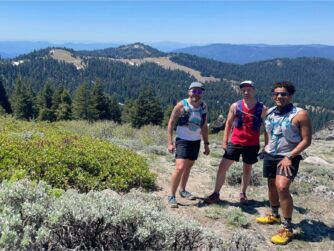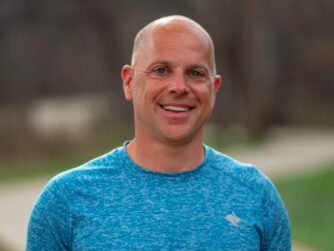Dr. Gangemi, AKA The Sock Doc, joins us as we discuss shoes, orthotics, ice, stretching and more. The Sock Doc is an accomplished athlete and an expert in soft tissue management and body mechanics. Sounds like a guy we would like to take on a run.
Please check us out on iTunes. Give us nice ratings and comments, thanks!
You can find us on iTunes or listen by using the player below.
Click here to download the file (Right click, save as)







After listening to this podcast and another one on barefoot running, I have a major question about orthotics. Both guests are against them because they don’t deal with the “original” injury. What about for people like me who have one leg shorter than the other? I have a 10mm difference in one leg (left femur bone is longer than the right femur bone) – are orthotics still unnecessary? How am I supposed to “fix” this problem without an orthotic? I would greatly appreciate a response from Mr. Gangemi on this issue, if possible. I just know that once I got the orthotic, I stopped getting injuries and callouses. Thank you for your help!
Rannelle, there are very few exceptions to orthotics. Here is a comprehensive article I wrote regarding such: https://sock-doc.com/2011/09/unnecessary-orthotics/. With a 10mm difference you may benefit from an orthotic, or you may not, as I mention in two separate patients I’ve seen with similar issues. Also, you may do better with a heel lift, or at least an orthotic that does not alter function, but merely makes up some of that 10mm difference. Hard to say without seeing you.
Dr. Gangemi
Hey Rannelle I too have a leg that is shorter than the other, in fact it is my secret power! Mine right leg is an inch shorter (fun factoid for you) and I too wonder if wearing my orthotics in my newton transition shoes is a good idea? What about wearing an orthotic in just the shorter leg shoe?
Most people have one leg longer (or shorter) than the other. It is often not a problem itself and is from a pelvic imbalance; an actual difference in true bone length is rare, as Rannelle says she has (though I don’t think 10mm is significant). So an orthotic or lift won’t fix the imbalance, and if you put it under the “short” leg then you’re just making up the difference from hip to ground. If you put the lift under the “long” leg you can often balance the pelvis (since the long leg is on the side that the pelvis is lower), but you’ll create other muscle imbalances. Point is – heel lifts, just like orthotics – bad idea.
In my case it’s a pelvic imbalance… I believe a good chiropractor can help reduce that. I’m not cured, but the imbalance is less than it was a few years ago.
I have to thank the Soc Dock for pointing out my piriformis muscle issue and way to heal it! I ditched my orthodics that I used in my Newton running shoes and I have moved into some different minimal shoes.
Derek – sweet!!! Orthotics are great to put under the uneven leg of a table so it doesn’t rock when you eat. I highly recommend them for that purpose. Custom orthotics, of course.
LOL! nice – I have kept a few pairs of my old orthotics (from when I used to have running injuries all the time) despite having not used them since I switched to barefoot (no more injuries) and minmalist a few years back…. Now I know what to do with them!
I have also found that by putting them heel lift to heel lift I can make a pretty good sounding instrument similar to playing the spoons.
It’s nice to hear that you can ditch the custom shoe orthotics after you find it has done its job. This is something I’ve done. I just can’t seem to toss them away though because they cost 70 bones. Maybe I can cut up into coasters. 🙂
This is all very well but what if you have arthritis in the mid foot and big toe joint? What then? I would have thought that additional stresses ‘sans orthotic’ would aggravate joint issues even more. Hallux rigidus arthritis of big toe – is a really common condition suffered by runners and the general population over 45yrs……
Arthritis (I assume you are referring to osteoarthritis), is from biomechanical problems – improper joint movement which then results in damage. The hallux rigidus began as hallux limitus from most likely, a weakness in the tibialis posterior muscle, and possibly other foot & lower leg muscles, including the big toe tendons themselves – the hallux longus and brevis. All this results in pronation problems too. So the treatment should be directed to these muscle via trigger point therapies and mobilization of the joints and muscles – not stabilization and support of them (via an orthothic). So I say and treat, the opposite; the more you stabilize the worse off you’ll be – you’re doing absolutely nothing to stop the problem from progressing. There’s an article I wrote here on joint repair you may find interest in. https://sock-doc.com/2011/10/joint-tissue-repair-gags/
What do you say to a person like me who has limited Dorsi/Planter flexion and NO Eversion/Inversion. I had a fusion done after a bad car accident. I run long distance and am training for a marathon now. I have these custom Orthotics you speak of to help with my running. I even trail run with this foot of mine and the fact that my motion is limited I do have issues that are caused from it. Are you telling me that in cases like mine that Orthotics is a bad idea if so what do you recommend because im sure it is different in every ones situation.